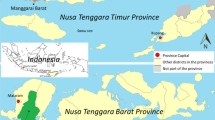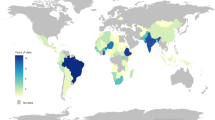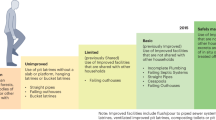Abstract
Globally, notable emphasis is currently being placed on improving access to and acceptance of sanitation in schools as part of the drive towards achieving the United Nations Sustainable Development Goal 6. However, the importance of sustaining effective cleaning of latrines in schools remains an under-emphasized and under-researched topic, with serious negative consequences for the health of school-aged children in low-income settings. In this Perspective, we summarize the limited existing literature on the impacts of unclean latrines in schools on aspects of child health, and the methods that have been trialled to achieve sustainable school latrine cleaning programmes. We highlight research needs and propose a new approach to school-led total sanitation, with the aim of moving towards a world in which no child gets sick because of the unhygienic state of the toilets in their schools.
This is a preview of subscription content, access via your institution
Access options
Subscribe to this journal
Receive 12 digital issues and online access to articles
$99.00 per year
only $8.25 per issue
Buy this article
- Purchase on Springer Link
- Instant access to full article PDF
Prices may be subject to local taxes which are calculated during checkout

Similar content being viewed by others
References
Chirgwin, H., Cairncross, S., Zehra, D. & Sharma Waddington, H. Interventions promoting uptake of water, sanitation and hygiene (WASH) technologies in low- and middle-income countries: an evidence and gap map of effectiveness studies. Campbell Syst. Rev. 17, e1194 (2021).
Igaki, S. et al. Effectiveness of community and school-based sanitation interventions in improving latrine coverage: a systematic review and meta-analysis of randomized controlled interventions. Environ. Health Prev. Med. 26, 26 (2021).
McMichael, C. Water, sanitation and hygiene (WASH) in schools in low-income countries: a review of evidence of impact. Int. J. Environ. Res. Public Health 16, 359 (2019).
De Buck, E. et al. Approaches to promote handwashing and sanitation behaviour change in low- and middle-income countries: a mixed method systematic review. Campbell Syst. Rev. 13, 1–447 (2017).
Staniford, L. J. & Schmidtke, K. A. A systematic review of hand-hygiene and environmental-disinfection interventions in settings with children. BMC Public Health 20, 195 (2020).
Dreibelbis, R. et al. Water, sanitation, and primary school attendance: a multi-level assessment of determinants of household-reported absence in Kenya. Int. J. Educ. Dev. 33, 457–465 (2013).
Freeman, M. C. et al. Assessing the impact of a school-based water treatment, hygiene and sanitation programme on pupil absence in Nyanza Province, Kenya: a cluster-randomized trial. Trop. Med. Int. Health 17, 380–391 (2012).
Greene, L. E. et al. Impact of a school-based hygiene promotion and sanitation intervention on pupil hand contamination in western Kenya: a cluster randomized trial. Am. J. Trop. Med. Hyg. 87, 385–393 (2012).
Caruso, B. A., Dreibelbis, R., Ogutu, E. A. & Rheingans, R. If you build it will they come? Factors influencing rural primary pupils’ urination and defecation practices at school in western Kenya. J. Water Sanit. Hyg. Dev. 4, 642–653 (2014).
Sclar, G. D. et al. Assessing the impact of sanitation on indicators of fecal exposure along principal transmission pathways: a systematic review. Int. J. Hyg. Environ. Health 219, 709–723 (2016).
Wolf, J. et al. Effectiveness of interventions to improve drinking water, sanitation, and handwashing with soap on risk of diarrhoeal disease in children in low-income and middle-income settings: a systematic review and meta-analysis. Lancet 400, 48–59 (2022).
Freeman, M. C. et al. The impact of sanitation on infectious disease and nutritional status: a systematic review and meta-analysis. Int. J. Hyg. Environ. Health 220, 928–949 (2017).
Prüss-Ustün, A. et al. Burden of disease from inadequate water, sanitation and hygiene for selected adverse health outcomes: an updated analysis with a focus on low- and middle-income countries. Int. J. Hyg. Environ. Health 222, 765–777 (2019).
Vaz Nery, S. et al. The role of water, sanitation and hygiene interventions in reducing soil-transmitted helminths: interpreting the evidence and identifying next steps. Parasit. Vectors 12, 273 (2019).
Garn, J. V. et al. Ascaris lumbricoides infection following school-based deworming in western Kenya: assessing the role of pupils’ school and home water, sanitation, and hygiene exposures. Am. J. Trop. Med. Hyg. 94, 1045–1054 (2016).
Gass, K., Addiss, D. G. & Freeman, M. C. Exploring the relationship between access to water, sanitation and hygiene and soil-transmitted helminth infection: a demonstration of two recursive partitioning tools. PLoS Negl.Trop. Dis. 8, e2945 (2014).
Gebrehiwot, T., Geberemariyam, B. S., Gebretsadik, T. & Gebresilassie, A. Prevalence of diarrheal diseases among schools with and without water, sanitation and hygiene programs in rural communities of north-eastern Ethiopia: a comparative cross-sectional study. Rural Remote Health https://doi.org/10.22605/RRH4907 (2020).
Grimes, J. E. T. et al. School water, sanitation and hygiene, soil-transmitted helminths, and schistosomes: national mapping in Ethiopia. PLoS Negl.Trop. Dis. 10, e0004515 (2016).
Cha, Y.-E., Fu, Y.-Z. & Yao, W. Knowledge, practice of personal hygiene, school sanitation, and risk factors of contracting diarrhea among rural students from five western provinces in China. Int. J. Environ. Res. Public Health 18, 9505 (2021).
Koopman, J. S. Diarrhea and school toilet hygiene in Cali, Columbia. Am. J. Epidemiol. 107, 412–420 (1978).
Libhaber, M., Troyano, F. & Ulloa, L. F. Improving Water and Sanitation Services in Colombian Muncipalities Through Private Operators (World Bank Group, 2004).
Rajaratnam, G., Patel, M., Parry, J. V., Perry, K. R. & Palmer, S. R. An outbreak of hepatitis A: school toilets as a source of transmission. J. Public Health Med. 14, 72–77 (1992).
Thomas, M. E. M. & Tillett, H. E. Sonne dysentery in day schools and nurseries: an eighteen-year study in Edmonton. J. Hyg. 71, 593–602 (1973).
Sugita, E. W. Water, sanitation and hygiene (WASH) in Japanese elementary schools: current conditions and practices. Pediatr. Int. 64, e15062 (2022).
Shoham, D. A. et al. School toileting environment, bullying, and lower urinary tract symptoms in a population of adolescent and young adult girls: preventing lower urinary tract symptoms consortium analysis of Avon Longitudinal Study of Parents and Children. Urology 151, 86–93 (2021).
Jørgensen, C. S., Breinbjerg, A. S., Rittig, S. & Kamperis, K. Dissatisfaction with school toilets is associated with bladder and bowel dysfunction. Eur. J. Pediatr. 180, 3317–3324 (2021).
Ending the Neglect to Attain the Sustainable Development Goals: A Road Map for Neglected Tropical Diseases 2021–2030 (World Health Organization, 2020).
Thys, S. et al. Why latrines are not used: communities’ perceptions and practices regarding latrines in a Taenia solium endemic rural area in eastern Zambia. PLoS Negl.Trop. Dis. 9, e0003570 (2015).
Garn, J. V. et al. Interventions to improve water, sanitation, and hygiene for preventing soil-transmitted helminth infection. Cochrane Database Syst. Rev. 6, Cd012199 (2022).
Tadege, B. et al. Assessment of environmental contamination with soil-transmitted helminths life stages at school compounds, households and open markets in Jimma Town, Ethiopia. PLoS Negl.Trop. Dis. 16, e0010307 (2022).
Enogiomwan Imalele, E., Offiong Effanga, E. & Ukam Usang, A. Environmental contamination by soil-transmitted helminths ova and subsequent infection in school-age children in Calabar, Nigeria. Sci. Afr. 19, e01580 (2023).
Mukiese Nlunda, J.-M., Nkiama Konde, J., Kapenga YambaYamba, M. & Mbela Kiyomba, G. Assessing school-based water, sanitation and hygiene (WASH) facilities in peri-urban settings of Kinshasa, DR Congo. Open J. Epidemiol. 13, 24–45 (2023).
Coswosk, É. D., Neves-Silva, P., Modena, C. M. & Heller, L. Having a toilet is not enough: the limitations in fulfilling the human rights to water and sanitation in a municipal school in Bahia, Brazil. BMC Public Health 19, 137 (2019).
Tsige, W., Kummie, A. & Dejene, T. Status of school sanitation service and factors affecting school water, sanitation and hygiene services: a school-based cross-sectional study. Environ. Pollut. Climate Change https://doi.org/10.4172/2573-458X.1000168 (2019).
Xuan, L. T. T., Hoat, L. N., Rheinländer, T., Dalsgaard, A. & Konradsen, F. Sanitation behavior among schoolchildren in a multi-ethnic area of northern rural Vietnam. BMC Public Health 12, 140 (2012).
Buxton, H. et al. The impact of an operation and management intervention on toilet usability in schools in the Philippines: a cluster randomised controlled trial. BMC Public Health 19, 1680 (2019).
Duijster, D. et al. Improving toilet usability and cleanliness in public schools in the Philippines using a packaged operation and maintenance intervention. Int. J. Environ. Res. Public Health 19, 10059 (2022).
Caruso, B. A. et al. Assessing the impact of a school-based latrine cleaning and handwashing program on pupil absence in Nyanza Province, Kenya: a cluster-randomized trial. Trop. Med. Int. Health 19, 1185–1197 (2014).
Chard, A. N. & Freeman, M. C. Design, intervention fidelity, and behavioral outcomes of a school-based water, sanitation, and hygiene cluster-randomized trial in Laos. Int. J. Environ. Res. Public Health 15, 570 (2018).
Alexander, K. T., Dreibelbis, R., Freeman, M. C., Ojeny, B. & Rheingans, R. Improving service delivery of water, sanitation, and hygiene in primary schools: a cluster-randomized trial in western Kenya. J. Water Health 11, 507–519 (2013).
Trinies, V., Garn, J. V., Chang, H. H. & Freeman, M. C. The impact of a school-based water, sanitation, and hygiene program on absenteeism, diarrhea, and respiratory infection: a matched–control trial in Mali. Am. J. Trop. Med. Hyg. 94, 1418–1425 (2016).
Adhikari, K. School led total sanitation: principles and practices. J. Water Sanit. Health Environ. 8, 8–10 (2010).
Winter, J. C., Darmstadt, G. L., Lee, S. J. & Davis, J. The potential of school-based WASH programming to support children as agents of change in rural Zambian households. BMC Public Health 21, 1812 (2021).
Venkataramanan, V., Crocker, J., Karon, A. & Bartram, J. Community-led total sanitation: a mixed-methods systematic review of evidence and Its quality. Environ. Health Perspect. 126, 026001 (2018).
Zuin, V. et al. Policy diffusion in the rural sanitation sector: lessons from community-led total sanitation (CLTS). World Dev. 124, 104643 (2019).
Lewis, J. Ending open defecation: a review of community-led sanitation programs. Environ. Health Perspect. 126, 044005 (2018).
Papafilippou, N., Templeton, M. R. & Ali, M. Is there a role for external technical support in the Community-Led Total Sanitation (CLTS) approach? Int. Dev. Plan. Rev. 33, 81–94 (2011).
Bardosh, K. Achieving ‘total sanitation’ in rural African geographies: poverty, participation and pit latrines in eastern Zambia. Geoforum 66, 53–63 (2015).
Engel, S. & Susilo, A. Shaming and sanitation in Indonesia: a return to colonial public health practices? Dev. Change 45, 157–178 (2014).
Galvin, M. Talking shit: is community-led total sanitation a radical and revolutionary approach to sanitation? WIREs Water 2, 9–20 (2015).
Joshi, D., Kooy, M. & van den Ouden, V. Development for children, or children for development? Examining children’s participation in school-led total sanitation programmes. Dev. Change 47, 1125–1145 (2016).
Brewis, A. & Wutich, A. Why we should never do it: stigma as a behaviour change tool in global health. BMJ Global Health 4, e001911 (2019).
Bateman, M. & Engel, S. To shame or not to shame—that is the sanitation question. Dev. Policy Rev. 36, 155–173 (2018).
Leontsini, E. & Winch, P. J. Increasing handwashing with soap: emotional drivers or social norms? Lancet Glob. Health 2, e118–e119 (2014).
Jacob Arriola, K. R. et al. Designing integrated interventions to improve nutrition and WASH behaviors in Kenya. Pilot Feasibility Stud. 6, 10 (2020).
Lambe, F. et al. Embracing complexity: a transdisciplinary conceptual framework for understanding behavior change in the context of development-focused interventions. World Dev. 126, 104703 (2020).
Vande Velde, F., Overgaard, H. J. & Bastien, S. Nudge strategies for behavior-based prevention and control of neglected tropical diseases: a scoping review and ethical assessment. PLoS Negl. Trop. Dis. 15, e0009239 (2021).
Ryan, R. M. & Deci, E. L. Intrinsic and extrinsic motivation from a self-determination theory perspective: definitions, theory, practices, and future directions. Contemp. Educ. Psychol. 61, 101860 (2020).
Bazzano, A. N., Martin, J., Hicks, E., Faughnan, M. & Murphy, L. Human-centred design in global health: a scoping review of applications and contexts. PLoS ONE 12, e0186744 (2017).
Chen, E., Leos, C., Kowitt, S. D. & Moracco, K. E. Enhancing community-based participatory research through human-centered design strategies. Health Promot. Pract. 21, 37–48 (2020).
Hendricks, S., Conrad, N., Douglas, T. S. & Mutsvangwa, T. A modified stakeholder participation assessment framework for design thinking in health innovation. Healthcare 6, 191–196 (2018).
Acknowledgements
M.R.T. was supported by the Royal Academy of Engineering under the Research Chairs and Senior Research Fellowships programme. F.V.V., B.L., S.G., Z.M. and M.R.T. have collaborated in this study as members of the Consortium of Experts in Neglected Tropical Diseases (www.centd.org). We thank L Sioné for her comments on the draft paper.
Author information
Authors and Affiliations
Contributions
F.V.V. led the writing of all parts of the paper except the section on the ‘Evidence of negative health outcomes’. B.L. and S.G. led the writing of the section on the ‘Evidence of negative health outcomes’. Z.M. and Z.B. contributed to all parts of the paper except the section on the ‘Evidence of negative health outcomes’. M.R.T. conceived the Perspective and contributed to and provided feedback on all parts.
Corresponding author
Ethics declarations
Competing interests
The authors declare no competing interests.
Peer review
Peer review information
Nature Water thanks Linda Strande and the other, anonymous, reviewer(s) for their contribution to the peer review of this work.
Additional information
Publisher’s note Springer Nature remains neutral with regard to jurisdictional claims in published maps and institutional affiliations.
Rights and permissions
Springer Nature or its licensor (e.g. a society or other partner) holds exclusive rights to this article under a publishing agreement with the author(s) or other rightsholder(s); author self-archiving of the accepted manuscript version of this article is solely governed by the terms of such publishing agreement and applicable law.
About this article
Cite this article
Vande Velde, F., Levecke, B., Gabriël, S. et al. Sustaining effective latrine cleaning in schools to protect child health in low-income settings. Nat Water 1, 907–914 (2023). https://doi.org/10.1038/s44221-023-00159-5
Received:
Accepted:
Published:
Issue Date:
DOI: https://doi.org/10.1038/s44221-023-00159-5



